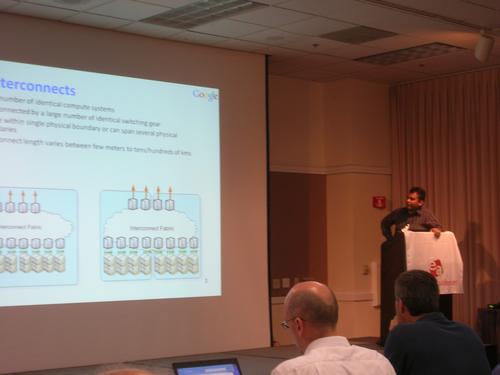Google Loosens Up on Data Center Optics
A loosening of the specs on optical modules might save money. Google wants to find out – and wants to know if Amazon and Facebook do too

SANTA CLARA, Calif. -- Google (Nasdaq: GOOG), realizing it isn't interested in the stringent requirements of the telecom network, is trying to craft a new standard for data-center optics.
The idea -- and that's all it is so far, with no immediate plans to submit anything to a standards body -- got its first public airing at the The Ethernet Alliance 's Technology Exploration Forum this morning, in a discussion that was supposed to be low on controversy.
Vijay Vusirikala, an optical architect with Google, explained that Google thinks it can save money and speed optical module development times by eliminating some of the corner cases that telecom gear is required to meet -- loosening the requirements, in other words. A Google data center never gets to 0 degrees Celsius, for instance -- so why does it need components built to withstand that temperature?
The concept is in line with Google's overall data center philosophy, where zillions of identical, cheap servers get thrown at every computing problem -- and get quickly thrown out if they fail.
Google's immediate objective is to see if other Internet data center owners -- Amazon.com Inc. (Nasdaq: AMZN) and Facebook , specifically -- even like the idea, said Chris Cole, Finisar Corp. (Nasdaq: FNSR) director of engineering, who headed the discussion.
Cole, Vusirikala, and Google honestly don't know the answer. As Cole put it, Amazon and Facebook are as quiet about their networks as Google was two years ago.
Cole and Google tried reaching out, with emails to eight owners of massive data centers, but they got no meaningful response. (Donn Lee, who's hit the conference circuit talking about Facebook's 100Gbit/s requirements, sent "something generic," Cole said. Amazon apparently sent nothing.)
So, Google is trying a new tactic: Writing a first-draft specification to see if it's something Amazon and Facebook care about.
The "standard" mainly involves removing corner-cases from the testing and design cycle. "What we are focused on relaxing are the things that take a lot of time up front," Vusirikala said.
Some of the suggestions include:
Looser temperature requirements, such as designing for a maximum temperature of 60 degrees Celsius rather than 70 or more;
A less stringent bit error rate than telecom is used to -- maybe 10-12 versus 10-15 for DWDM equipment;
About 1,000 hours of accelerated aging tests, which is half the norm.
Google has no quarrel with most other Telcordia Technologies Inc. specifications, such as temperature-cycling tests or requirements for withstanding vibration.
Vusirikala told Light Reading that his talk wasn't meant to be as controversial as, say, Google's criticism of standard 100Gbit/s optics, which came out at the recent European Conference and Exhibition on Optical Communication (ECOC). (See 100G Watch: Google Complains Again.)
But some, including the Brocade Communications Systems Inc. (Nasdaq: BRCD) and Cisco Systems Inc. (Nasdaq: CSCO) representatives who'd been invited to present talks as part of Cole's session, misinterpreted Google's proto-standard, thinking it would require entire systems to be redesigned.
Easy there, Vusirikala said. All Google is talking about is a cheaper type of pluggable optical module. Google buys its optics directly from the module vendors, so this isn't something that systems vendors need to think about.
Optical components and module vendors would stand to gain the most from Google's idea, since the extreme corners of the telecom specifications help drive costs upward. As Vusirikala put it, the extra engineering margin means less profit margin for the module vendor.
The question, as Cole told Light Reading, is whether Google and its ilk represent a big enough market to make the idea work.
The best-case scenario would be that Google is a leading indicator. "If it is a successful market, and people realize there are lots of benefits to this, people could try to design their own data centers like this," he said.
In fact, the Cisco and Brocade talks showed some potential benefits of Google's approach. For example, if the maximum temperature of an optical transceiver is assumed to be lower -- meaning you're no longer building to worst-case scenarios -- that creates the leeway to put more power into certain components, possibly increasing throughput.
These are all maybes, and Google knows it. Even if other companies like the idea, it's still yet to be seen if the expected benefits come to life. "If there's no gain for us, we don't seen any need for more thrust behind this proposal," Vusirikala said.
— Craig Matsumoto, West Coast Editor, Light Reading
About the Author(s)
You May Also Like




_International_Software_Products.jpeg?width=300&auto=webp&quality=80&disable=upscale)







